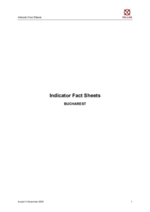Study of congestion charging and dialogue on pricing
Summary
To assess whether introducing congestion charging in Zagreb is a realistic possibility, the city carried out a feasibility study. Zagreb will also draw on the knowledge of other cities that have already introduced some form of vehicle entry restrictions.
Implementing sustainable mobility
In recent years Zagreb has experienced a drastic growth in the level of motorisation. This has had a huge impact on the environment and the traffic situation. The large number of personal cars in the city centre is result of an insufficient road network in the northern part of the city, thus requiring all vehicles to travel across the city centre to go from east to west. There is also an inadequate level of public transport with an insufficient number of vehicles and an ill equipped management system.
The study proposes modalities for introducing congestion charging in the city centre, and defining the exact target area. It also familiarised the public with the possible positive results of such a measure, thus ensuring their support for its implementation. There was also a focus on mitigating the impact of private and transport vehicles on the city environment and finding the most appropriate instruments to achieve its purpose.
Progress
Based on well-established technical solutions of urban road charging, an analysis of applied urban charging strategies, and an analysis of the existing transport system of the city of Zagreb, the proposed preliminary solution suggests the introduction of an Eco Zone in the City of Zagreb. The main objective is not to generate income but to reduce congestion and improving air quality. The potential funds should go into the development of a congestion charging scheme and in the implementation of measures that discourage the use of personal vehicles.
The Eco Zone will be designed to cover an area in the city centre of about 2 km². To enter the zone, drivers need to obtain an annual vignette. The price of the vignette depends on the type of engine, i.e. engines with a lower Euro-standard (bigger polluters) will pay a higher amount. Vignettes are categorised into five types (green, yellow, red, grey and white). White vignettes are related to electric vehicles and hybrid vehicles. These will be able to enter free of charge. The penalty for not having a vignette will be as much as the price of the most expensive vignettes (€133.33 or 1,000 kn). Vignettes will apply to Croatian number plates.
Based on data obtained from the Croatian Centre for Vehicles, the projected number of passenger cars and a trend analysis, an estimate was made for purchased vignettes by type until the year 2017. The above analysis, forecasts and estimates will be used as input data for the CBA analysis. As this study is only an initial step in the implementation of congestion charging, i.e. a measure that is quite restrictive for users, it is approached carefully. It is important for the city to reach high levels of acceptance for this proposed solution by stakeholders (more than 60%).
Outcomes
Since there was no real life implementation of the congestion charging, the evaluation results are not easily quantifiable. However, the following impact was achieved:
- The acceptance level of the congestion charging concept among the citizens was raised by 6%.
- The acceptance level of the congestion charging concept among business subjects was raised by 8%.
- The most important result of the measure is, of course, the study itself. Based on the local conditions and challenges, as well as the available literature on this matter, the study proposed the solution for implementation of congestion charging scheme in the city. The study serves as an excellent starting point for future project of introducing the congestion charging in the City of Zagreb because it gives a clear recommendation how to implement congestion charging. It also contributed to the increased level of acceptance among stakeholders and citizens (mentioned above).








